Strategic Planning for Uber: An Analysis of Business Environment
VerifiedAdded on 2023/01/05
|16
|5300
|100
Report
AI Summary
This report provides a comprehensive analysis of Uber's business strategy, examining both the external macro environment and internal capabilities. It employs frameworks such as PESTLE to assess political, economic, social, technological, environmental, and legal factors impacting Uber's operations. The report also utilizes SWOT analysis to identify Uber's strengths, weaknesses, opportunities, and threats, along with Porter's Five Forces to evaluate the competitive landscape. Furthermore, it explores Uber's internal environment using the Resource-Based View, McKinsey's 7-S model, and VRIO analysis to understand its strategic capabilities and competitive advantages. The report also touches upon Ansoff's Growth Matrix, benchmarking and provides insights into potential growth strategies for Uber, with a focus on market penetration. This detailed analysis aims to provide a holistic understanding of Uber's strategic position and potential future directions.
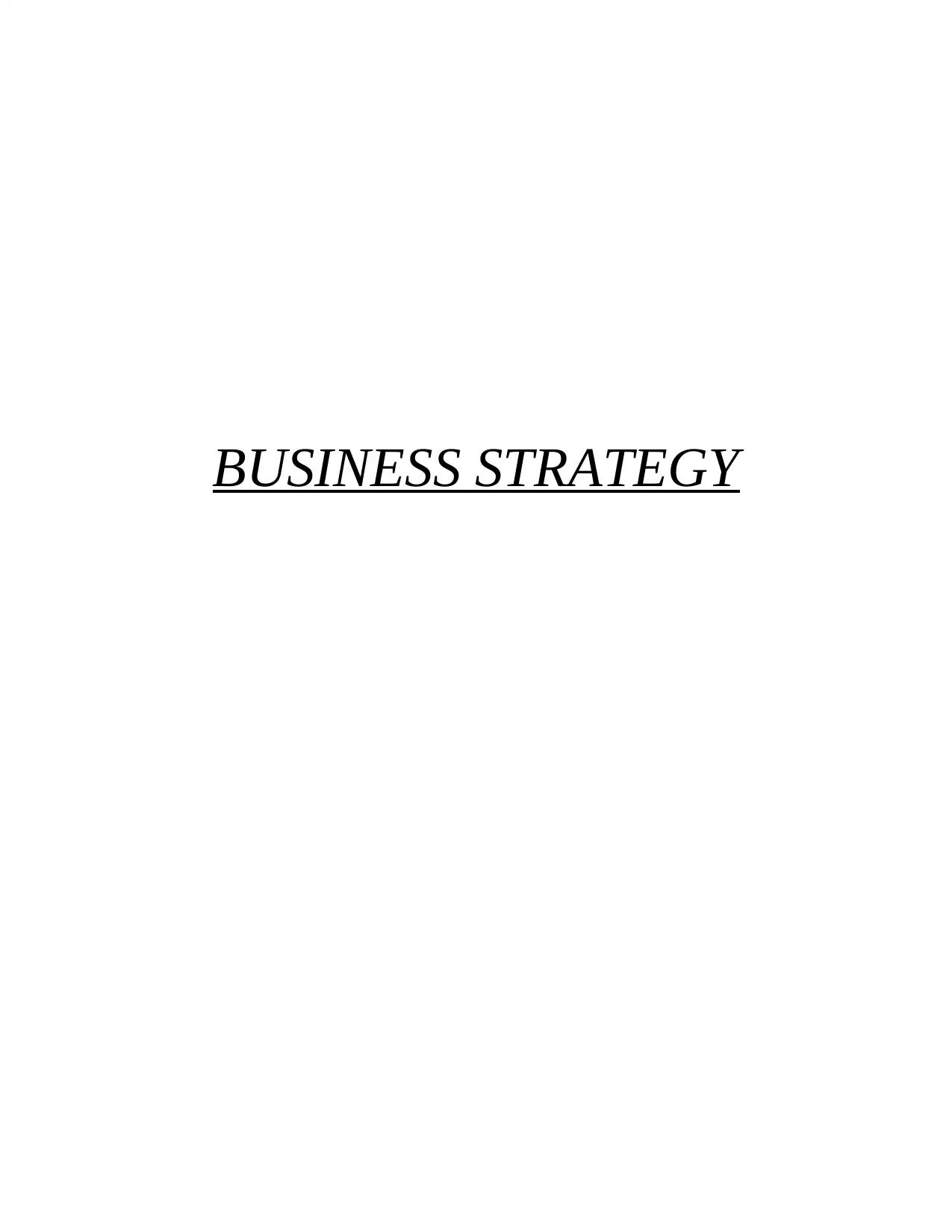
BUSINESS STRATEGY
Paraphrase This Document
Need a fresh take? Get an instant paraphrase of this document with our AI Paraphraser
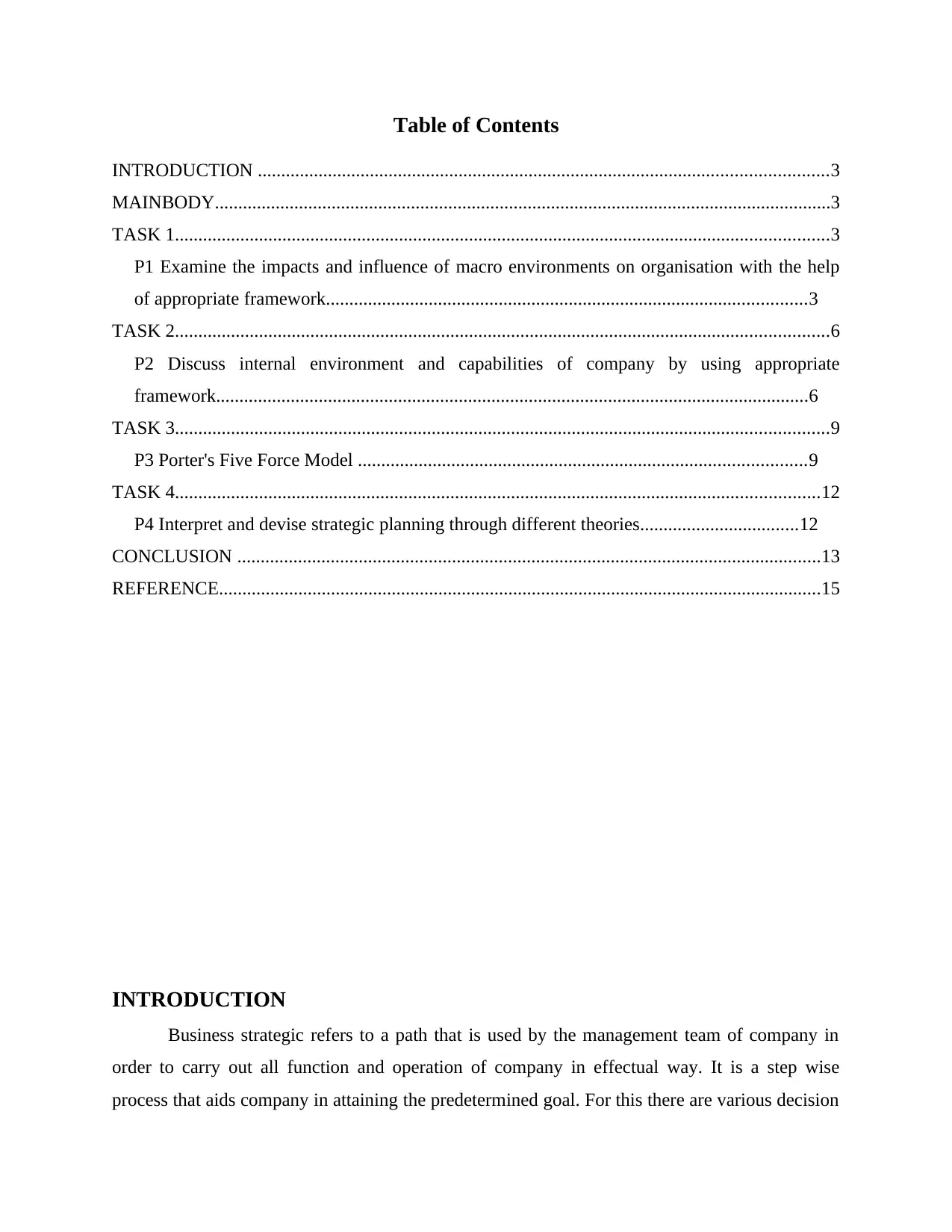
Table of Contents
INTRODUCTION ..........................................................................................................................3
MAINBODY....................................................................................................................................3
TASK 1............................................................................................................................................3
P1 Examine the impacts and influence of macro environments on organisation with the help
of appropriate framework.......................................................................................................3
TASK 2............................................................................................................................................6
P2 Discuss internal environment and capabilities of company by using appropriate
framework...............................................................................................................................6
TASK 3............................................................................................................................................9
P3 Porter's Five Force Model ................................................................................................9
TASK 4..........................................................................................................................................12
P4 Interpret and devise strategic planning through different theories..................................12
CONCLUSION .............................................................................................................................13
REFERENCE.................................................................................................................................15
INTRODUCTION
Business strategic refers to a path that is used by the management team of company in
order to carry out all function and operation of company in effectual way. It is a step wise
process that aids company in attaining the predetermined goal. For this there are various decision
INTRODUCTION ..........................................................................................................................3
MAINBODY....................................................................................................................................3
TASK 1............................................................................................................................................3
P1 Examine the impacts and influence of macro environments on organisation with the help
of appropriate framework.......................................................................................................3
TASK 2............................................................................................................................................6
P2 Discuss internal environment and capabilities of company by using appropriate
framework...............................................................................................................................6
TASK 3............................................................................................................................................9
P3 Porter's Five Force Model ................................................................................................9
TASK 4..........................................................................................................................................12
P4 Interpret and devise strategic planning through different theories..................................12
CONCLUSION .............................................................................................................................13
REFERENCE.................................................................................................................................15
INTRODUCTION
Business strategic refers to a path that is used by the management team of company in
order to carry out all function and operation of company in effectual way. It is a step wise
process that aids company in attaining the predetermined goal. For this there are various decision
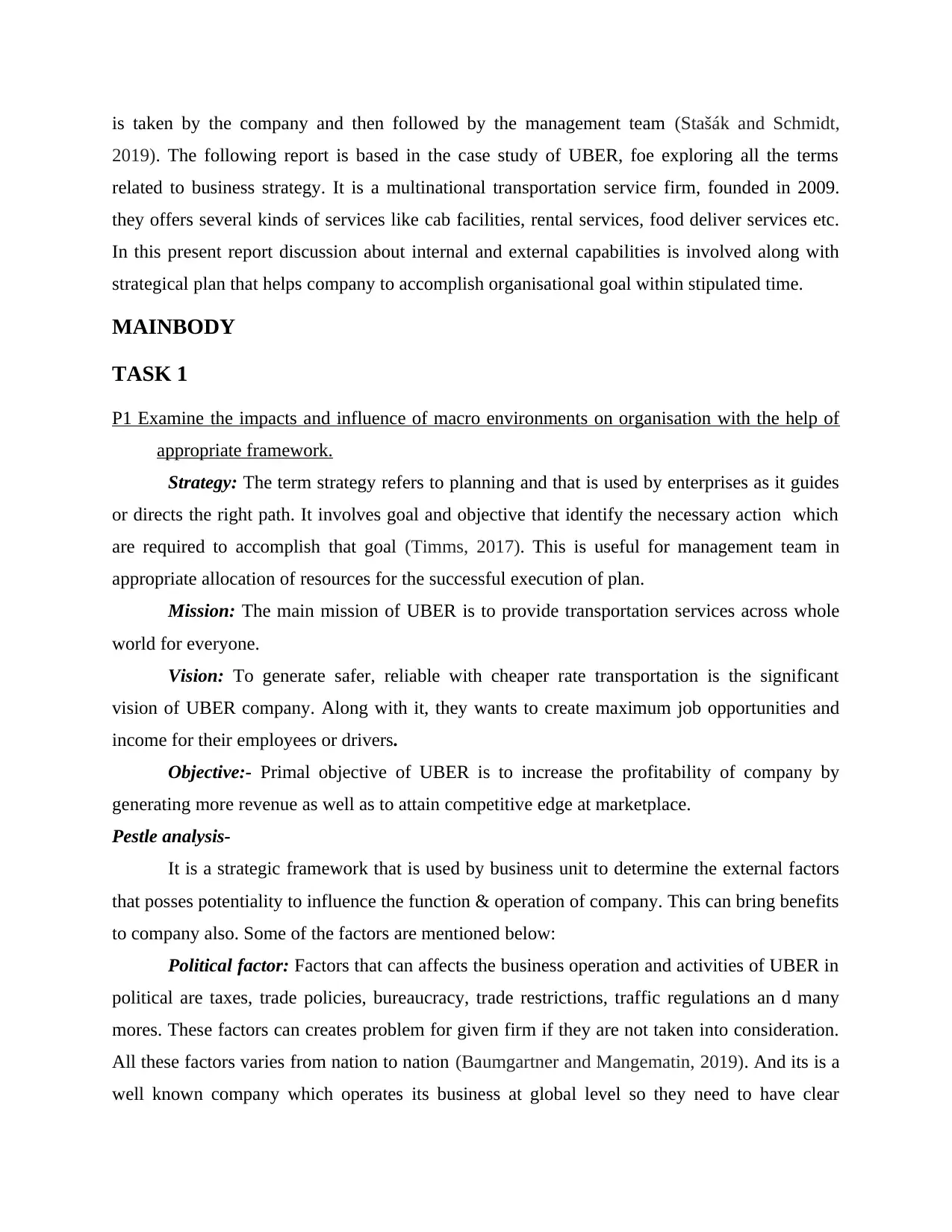
is taken by the company and then followed by the management team (Stašák and Schmidt,
2019). The following report is based in the case study of UBER, foe exploring all the terms
related to business strategy. It is a multinational transportation service firm, founded in 2009.
they offers several kinds of services like cab facilities, rental services, food deliver services etc.
In this present report discussion about internal and external capabilities is involved along with
strategical plan that helps company to accomplish organisational goal within stipulated time.
MAINBODY
TASK 1
P1 Examine the impacts and influence of macro environments on organisation with the help of
appropriate framework.
Strategy: The term strategy refers to planning and that is used by enterprises as it guides
or directs the right path. It involves goal and objective that identify the necessary action which
are required to accomplish that goal (Timms, 2017). This is useful for management team in
appropriate allocation of resources for the successful execution of plan.
Mission: The main mission of UBER is to provide transportation services across whole
world for everyone.
Vision: To generate safer, reliable with cheaper rate transportation is the significant
vision of UBER company. Along with it, they wants to create maximum job opportunities and
income for their employees or drivers.
Objective:- Primal objective of UBER is to increase the profitability of company by
generating more revenue as well as to attain competitive edge at marketplace.
Pestle analysis-
It is a strategic framework that is used by business unit to determine the external factors
that posses potentiality to influence the function & operation of company. This can bring benefits
to company also. Some of the factors are mentioned below:
Political factor: Factors that can affects the business operation and activities of UBER in
political are taxes, trade policies, bureaucracy, trade restrictions, traffic regulations an d many
mores. These factors can creates problem for given firm if they are not taken into consideration.
All these factors varies from nation to nation (Baumgartner and Mangematin, 2019). And its is a
well known company which operates its business at global level so they need to have clear
2019). The following report is based in the case study of UBER, foe exploring all the terms
related to business strategy. It is a multinational transportation service firm, founded in 2009.
they offers several kinds of services like cab facilities, rental services, food deliver services etc.
In this present report discussion about internal and external capabilities is involved along with
strategical plan that helps company to accomplish organisational goal within stipulated time.
MAINBODY
TASK 1
P1 Examine the impacts and influence of macro environments on organisation with the help of
appropriate framework.
Strategy: The term strategy refers to planning and that is used by enterprises as it guides
or directs the right path. It involves goal and objective that identify the necessary action which
are required to accomplish that goal (Timms, 2017). This is useful for management team in
appropriate allocation of resources for the successful execution of plan.
Mission: The main mission of UBER is to provide transportation services across whole
world for everyone.
Vision: To generate safer, reliable with cheaper rate transportation is the significant
vision of UBER company. Along with it, they wants to create maximum job opportunities and
income for their employees or drivers.
Objective:- Primal objective of UBER is to increase the profitability of company by
generating more revenue as well as to attain competitive edge at marketplace.
Pestle analysis-
It is a strategic framework that is used by business unit to determine the external factors
that posses potentiality to influence the function & operation of company. This can bring benefits
to company also. Some of the factors are mentioned below:
Political factor: Factors that can affects the business operation and activities of UBER in
political are taxes, trade policies, bureaucracy, trade restrictions, traffic regulations an d many
mores. These factors can creates problem for given firm if they are not taken into consideration.
All these factors varies from nation to nation (Baumgartner and Mangematin, 2019). And its is a
well known company which operates its business at global level so they need to have clear
⊘ This is a preview!⊘
Do you want full access?
Subscribe today to unlock all pages.

Trusted by 1+ million students worldwide
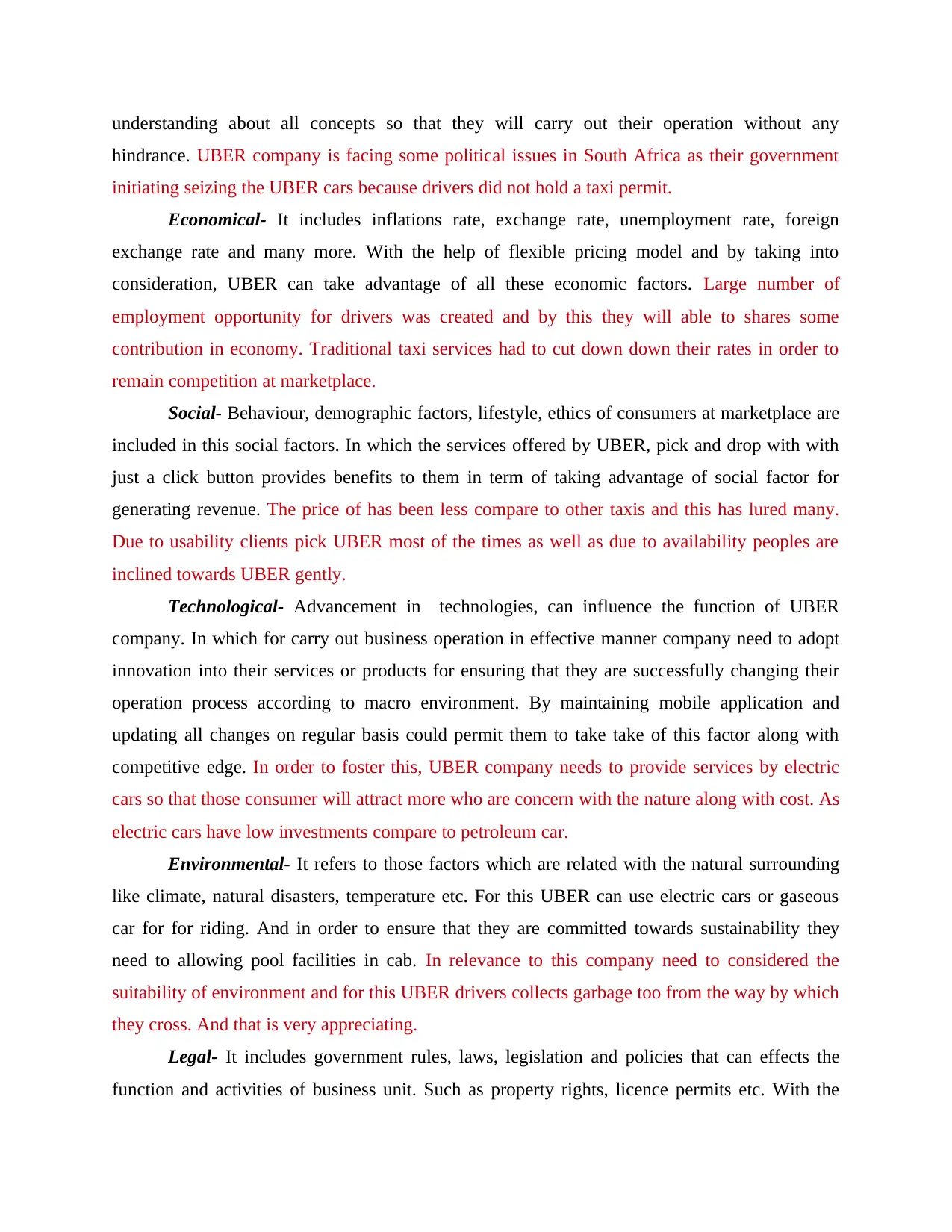
understanding about all concepts so that they will carry out their operation without any
hindrance. UBER company is facing some political issues in South Africa as their government
initiating seizing the UBER cars because drivers did not hold a taxi permit.
Economical- It includes inflations rate, exchange rate, unemployment rate, foreign
exchange rate and many more. With the help of flexible pricing model and by taking into
consideration, UBER can take advantage of all these economic factors. Large number of
employment opportunity for drivers was created and by this they will able to shares some
contribution in economy. Traditional taxi services had to cut down down their rates in order to
remain competition at marketplace.
Social- Behaviour, demographic factors, lifestyle, ethics of consumers at marketplace are
included in this social factors. In which the services offered by UBER, pick and drop with with
just a click button provides benefits to them in term of taking advantage of social factor for
generating revenue. The price of has been less compare to other taxis and this has lured many.
Due to usability clients pick UBER most of the times as well as due to availability peoples are
inclined towards UBER gently.
Technological- Advancement in technologies, can influence the function of UBER
company. In which for carry out business operation in effective manner company need to adopt
innovation into their services or products for ensuring that they are successfully changing their
operation process according to macro environment. By maintaining mobile application and
updating all changes on regular basis could permit them to take take of this factor along with
competitive edge. In order to foster this, UBER company needs to provide services by electric
cars so that those consumer will attract more who are concern with the nature along with cost. As
electric cars have low investments compare to petroleum car.
Environmental- It refers to those factors which are related with the natural surrounding
like climate, natural disasters, temperature etc. For this UBER can use electric cars or gaseous
car for for riding. And in order to ensure that they are committed towards sustainability they
need to allowing pool facilities in cab. In relevance to this company need to considered the
suitability of environment and for this UBER drivers collects garbage too from the way by which
they cross. And that is very appreciating.
Legal- It includes government rules, laws, legislation and policies that can effects the
function and activities of business unit. Such as property rights, licence permits etc. With the
hindrance. UBER company is facing some political issues in South Africa as their government
initiating seizing the UBER cars because drivers did not hold a taxi permit.
Economical- It includes inflations rate, exchange rate, unemployment rate, foreign
exchange rate and many more. With the help of flexible pricing model and by taking into
consideration, UBER can take advantage of all these economic factors. Large number of
employment opportunity for drivers was created and by this they will able to shares some
contribution in economy. Traditional taxi services had to cut down down their rates in order to
remain competition at marketplace.
Social- Behaviour, demographic factors, lifestyle, ethics of consumers at marketplace are
included in this social factors. In which the services offered by UBER, pick and drop with with
just a click button provides benefits to them in term of taking advantage of social factor for
generating revenue. The price of has been less compare to other taxis and this has lured many.
Due to usability clients pick UBER most of the times as well as due to availability peoples are
inclined towards UBER gently.
Technological- Advancement in technologies, can influence the function of UBER
company. In which for carry out business operation in effective manner company need to adopt
innovation into their services or products for ensuring that they are successfully changing their
operation process according to macro environment. By maintaining mobile application and
updating all changes on regular basis could permit them to take take of this factor along with
competitive edge. In order to foster this, UBER company needs to provide services by electric
cars so that those consumer will attract more who are concern with the nature along with cost. As
electric cars have low investments compare to petroleum car.
Environmental- It refers to those factors which are related with the natural surrounding
like climate, natural disasters, temperature etc. For this UBER can use electric cars or gaseous
car for for riding. And in order to ensure that they are committed towards sustainability they
need to allowing pool facilities in cab. In relevance to this company need to considered the
suitability of environment and for this UBER drivers collects garbage too from the way by which
they cross. And that is very appreciating.
Legal- It includes government rules, laws, legislation and policies that can effects the
function and activities of business unit. Such as property rights, licence permits etc. With the
Paraphrase This Document
Need a fresh take? Get an instant paraphrase of this document with our AI Paraphraser
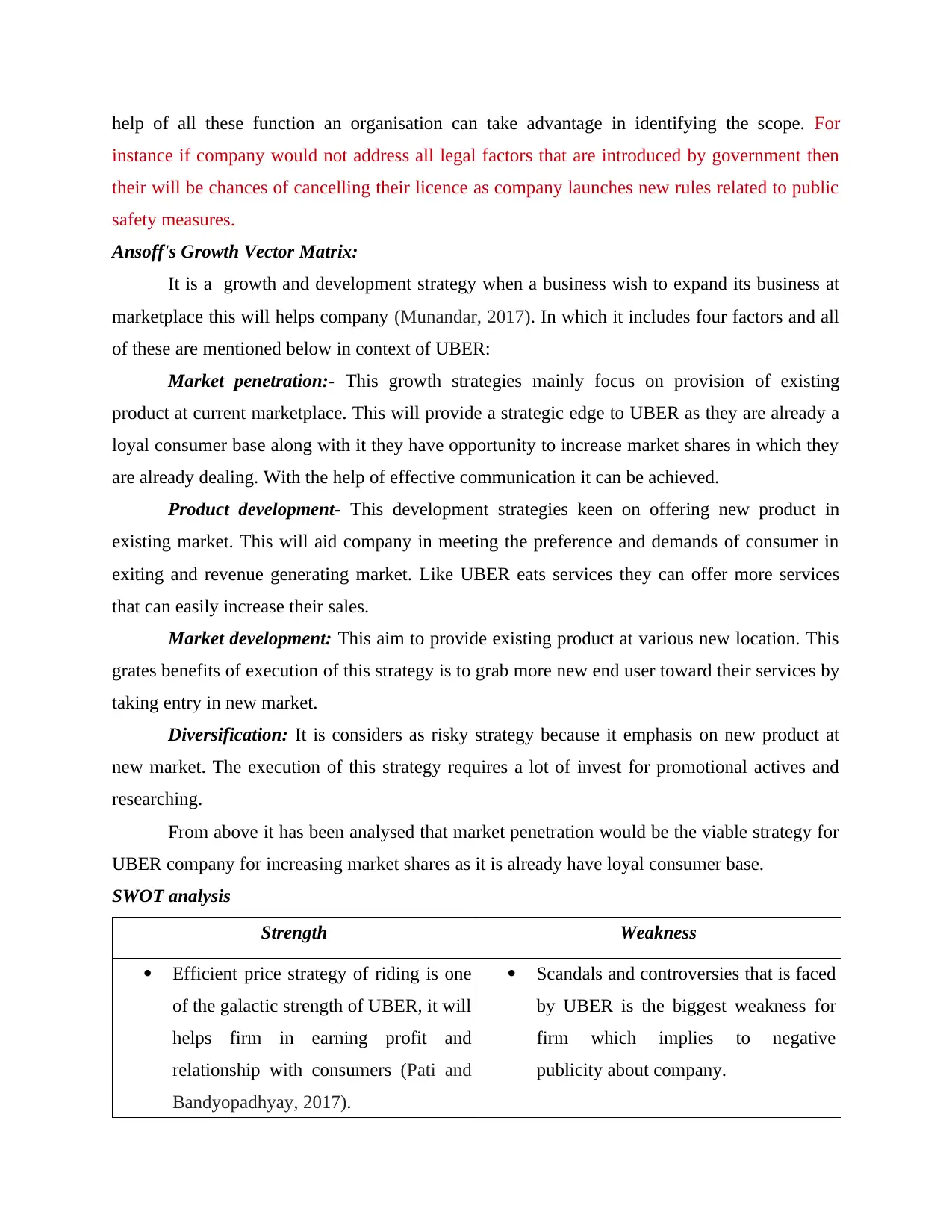
help of all these function an organisation can take advantage in identifying the scope. For
instance if company would not address all legal factors that are introduced by government then
their will be chances of cancelling their licence as company launches new rules related to public
safety measures.
Ansoff's Growth Vector Matrix:
It is a growth and development strategy when a business wish to expand its business at
marketplace this will helps company (Munandar, 2017). In which it includes four factors and all
of these are mentioned below in context of UBER:
Market penetration:- This growth strategies mainly focus on provision of existing
product at current marketplace. This will provide a strategic edge to UBER as they are already a
loyal consumer base along with it they have opportunity to increase market shares in which they
are already dealing. With the help of effective communication it can be achieved.
Product development- This development strategies keen on offering new product in
existing market. This will aid company in meeting the preference and demands of consumer in
exiting and revenue generating market. Like UBER eats services they can offer more services
that can easily increase their sales.
Market development: This aim to provide existing product at various new location. This
grates benefits of execution of this strategy is to grab more new end user toward their services by
taking entry in new market.
Diversification: It is considers as risky strategy because it emphasis on new product at
new market. The execution of this strategy requires a lot of invest for promotional actives and
researching.
From above it has been analysed that market penetration would be the viable strategy for
UBER company for increasing market shares as it is already have loyal consumer base.
SWOT analysis
Strength Weakness
Efficient price strategy of riding is one
of the galactic strength of UBER, it will
helps firm in earning profit and
relationship with consumers (Pati and
Bandyopadhyay, 2017).
Scandals and controversies that is faced
by UBER is the biggest weakness for
firm which implies to negative
publicity about company.
instance if company would not address all legal factors that are introduced by government then
their will be chances of cancelling their licence as company launches new rules related to public
safety measures.
Ansoff's Growth Vector Matrix:
It is a growth and development strategy when a business wish to expand its business at
marketplace this will helps company (Munandar, 2017). In which it includes four factors and all
of these are mentioned below in context of UBER:
Market penetration:- This growth strategies mainly focus on provision of existing
product at current marketplace. This will provide a strategic edge to UBER as they are already a
loyal consumer base along with it they have opportunity to increase market shares in which they
are already dealing. With the help of effective communication it can be achieved.
Product development- This development strategies keen on offering new product in
existing market. This will aid company in meeting the preference and demands of consumer in
exiting and revenue generating market. Like UBER eats services they can offer more services
that can easily increase their sales.
Market development: This aim to provide existing product at various new location. This
grates benefits of execution of this strategy is to grab more new end user toward their services by
taking entry in new market.
Diversification: It is considers as risky strategy because it emphasis on new product at
new market. The execution of this strategy requires a lot of invest for promotional actives and
researching.
From above it has been analysed that market penetration would be the viable strategy for
UBER company for increasing market shares as it is already have loyal consumer base.
SWOT analysis
Strength Weakness
Efficient price strategy of riding is one
of the galactic strength of UBER, it will
helps firm in earning profit and
relationship with consumers (Pati and
Bandyopadhyay, 2017).
Scandals and controversies that is faced
by UBER is the biggest weakness for
firm which implies to negative
publicity about company.
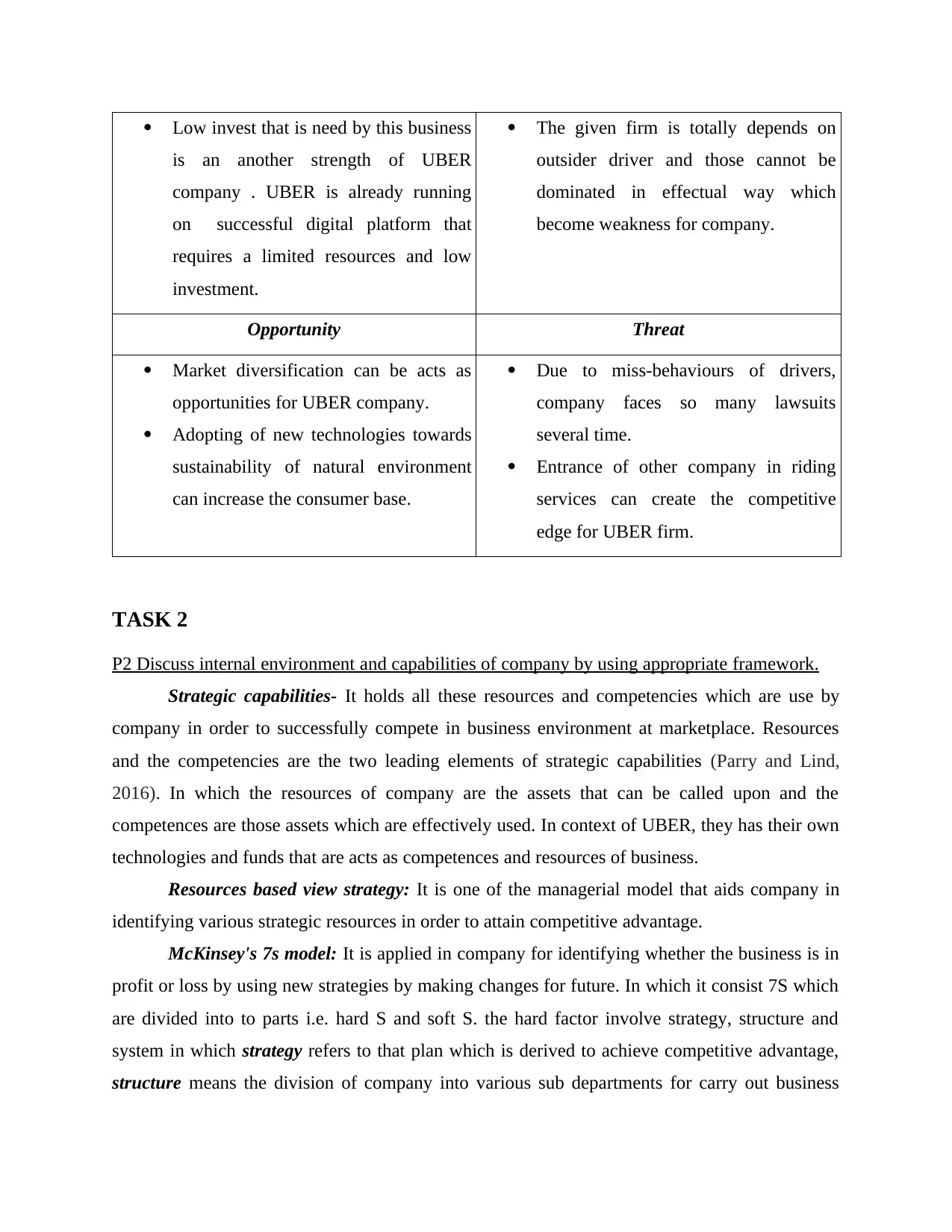
Low invest that is need by this business
is an another strength of UBER
company . UBER is already running
on successful digital platform that
requires a limited resources and low
investment.
The given firm is totally depends on
outsider driver and those cannot be
dominated in effectual way which
become weakness for company.
Opportunity Threat
Market diversification can be acts as
opportunities for UBER company.
Adopting of new technologies towards
sustainability of natural environment
can increase the consumer base.
Due to miss-behaviours of drivers,
company faces so many lawsuits
several time.
Entrance of other company in riding
services can create the competitive
edge for UBER firm.
TASK 2
P2 Discuss internal environment and capabilities of company by using appropriate framework.
Strategic capabilities- It holds all these resources and competencies which are use by
company in order to successfully compete in business environment at marketplace. Resources
and the competencies are the two leading elements of strategic capabilities (Parry and Lind,
2016). In which the resources of company are the assets that can be called upon and the
competences are those assets which are effectively used. In context of UBER, they has their own
technologies and funds that are acts as competences and resources of business.
Resources based view strategy: It is one of the managerial model that aids company in
identifying various strategic resources in order to attain competitive advantage.
McKinsey's 7s model: It is applied in company for identifying whether the business is in
profit or loss by using new strategies by making changes for future. In which it consist 7S which
are divided into to parts i.e. hard S and soft S. the hard factor involve strategy, structure and
system in which strategy refers to that plan which is derived to achieve competitive advantage,
structure means the division of company into various sub departments for carry out business
is an another strength of UBER
company . UBER is already running
on successful digital platform that
requires a limited resources and low
investment.
The given firm is totally depends on
outsider driver and those cannot be
dominated in effectual way which
become weakness for company.
Opportunity Threat
Market diversification can be acts as
opportunities for UBER company.
Adopting of new technologies towards
sustainability of natural environment
can increase the consumer base.
Due to miss-behaviours of drivers,
company faces so many lawsuits
several time.
Entrance of other company in riding
services can create the competitive
edge for UBER firm.
TASK 2
P2 Discuss internal environment and capabilities of company by using appropriate framework.
Strategic capabilities- It holds all these resources and competencies which are use by
company in order to successfully compete in business environment at marketplace. Resources
and the competencies are the two leading elements of strategic capabilities (Parry and Lind,
2016). In which the resources of company are the assets that can be called upon and the
competences are those assets which are effectively used. In context of UBER, they has their own
technologies and funds that are acts as competences and resources of business.
Resources based view strategy: It is one of the managerial model that aids company in
identifying various strategic resources in order to attain competitive advantage.
McKinsey's 7s model: It is applied in company for identifying whether the business is in
profit or loss by using new strategies by making changes for future. In which it consist 7S which
are divided into to parts i.e. hard S and soft S. the hard factor involve strategy, structure and
system in which strategy refers to that plan which is derived to achieve competitive advantage,
structure means the division of company into various sub departments for carry out business
⊘ This is a preview!⊘
Do you want full access?
Subscribe today to unlock all pages.

Trusted by 1+ million students worldwide
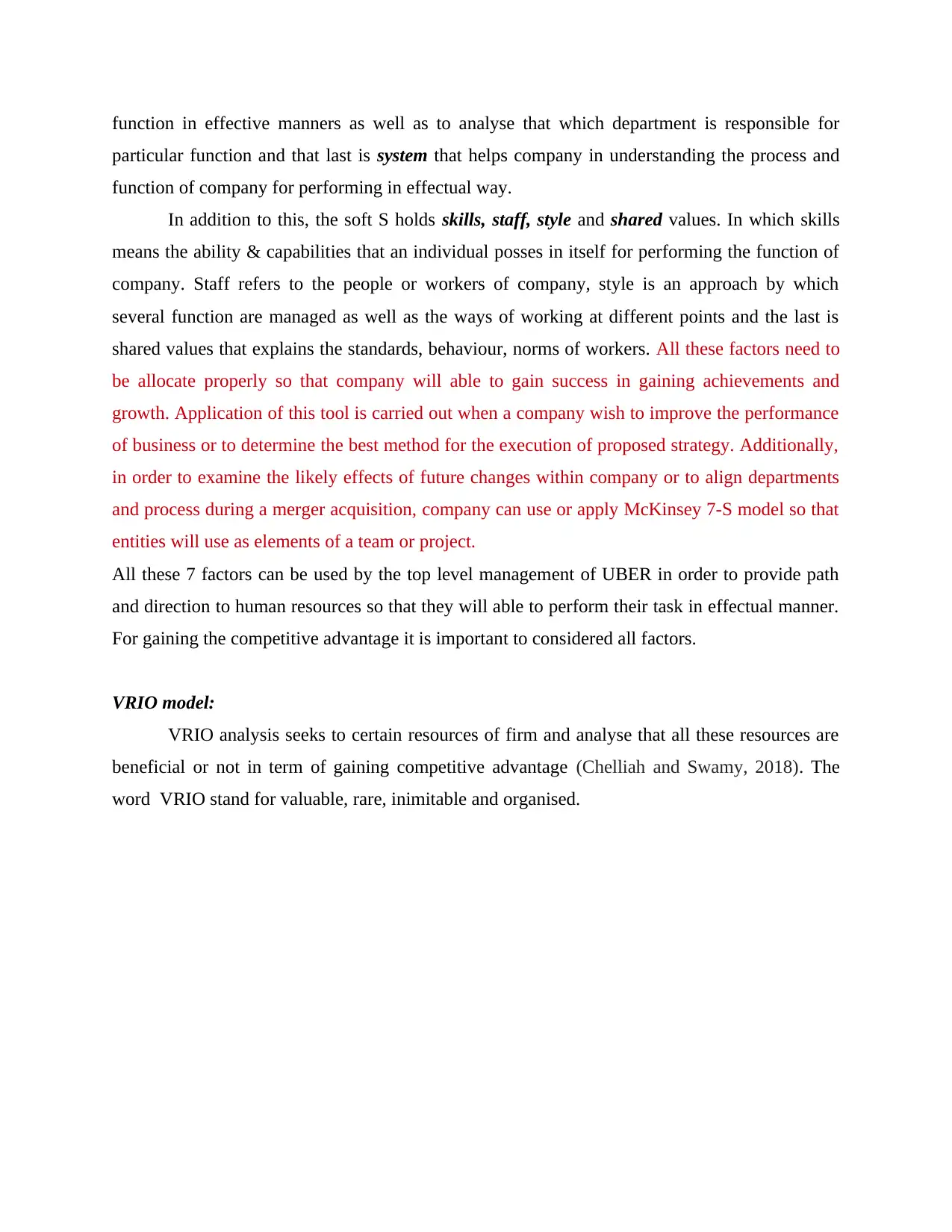
function in effective manners as well as to analyse that which department is responsible for
particular function and that last is system that helps company in understanding the process and
function of company for performing in effectual way.
In addition to this, the soft S holds skills, staff, style and shared values. In which skills
means the ability & capabilities that an individual posses in itself for performing the function of
company. Staff refers to the people or workers of company, style is an approach by which
several function are managed as well as the ways of working at different points and the last is
shared values that explains the standards, behaviour, norms of workers. All these factors need to
be allocate properly so that company will able to gain success in gaining achievements and
growth. Application of this tool is carried out when a company wish to improve the performance
of business or to determine the best method for the execution of proposed strategy. Additionally,
in order to examine the likely effects of future changes within company or to align departments
and process during a merger acquisition, company can use or apply McKinsey 7-S model so that
entities will use as elements of a team or project.
All these 7 factors can be used by the top level management of UBER in order to provide path
and direction to human resources so that they will able to perform their task in effectual manner.
For gaining the competitive advantage it is important to considered all factors.
VRIO model:
VRIO analysis seeks to certain resources of firm and analyse that all these resources are
beneficial or not in term of gaining competitive advantage (Chelliah and Swamy, 2018). The
word VRIO stand for valuable, rare, inimitable and organised.
particular function and that last is system that helps company in understanding the process and
function of company for performing in effectual way.
In addition to this, the soft S holds skills, staff, style and shared values. In which skills
means the ability & capabilities that an individual posses in itself for performing the function of
company. Staff refers to the people or workers of company, style is an approach by which
several function are managed as well as the ways of working at different points and the last is
shared values that explains the standards, behaviour, norms of workers. All these factors need to
be allocate properly so that company will able to gain success in gaining achievements and
growth. Application of this tool is carried out when a company wish to improve the performance
of business or to determine the best method for the execution of proposed strategy. Additionally,
in order to examine the likely effects of future changes within company or to align departments
and process during a merger acquisition, company can use or apply McKinsey 7-S model so that
entities will use as elements of a team or project.
All these 7 factors can be used by the top level management of UBER in order to provide path
and direction to human resources so that they will able to perform their task in effectual manner.
For gaining the competitive advantage it is important to considered all factors.
VRIO model:
VRIO analysis seeks to certain resources of firm and analyse that all these resources are
beneficial or not in term of gaining competitive advantage (Chelliah and Swamy, 2018). The
word VRIO stand for valuable, rare, inimitable and organised.
Paraphrase This Document
Need a fresh take? Get an instant paraphrase of this document with our AI Paraphraser
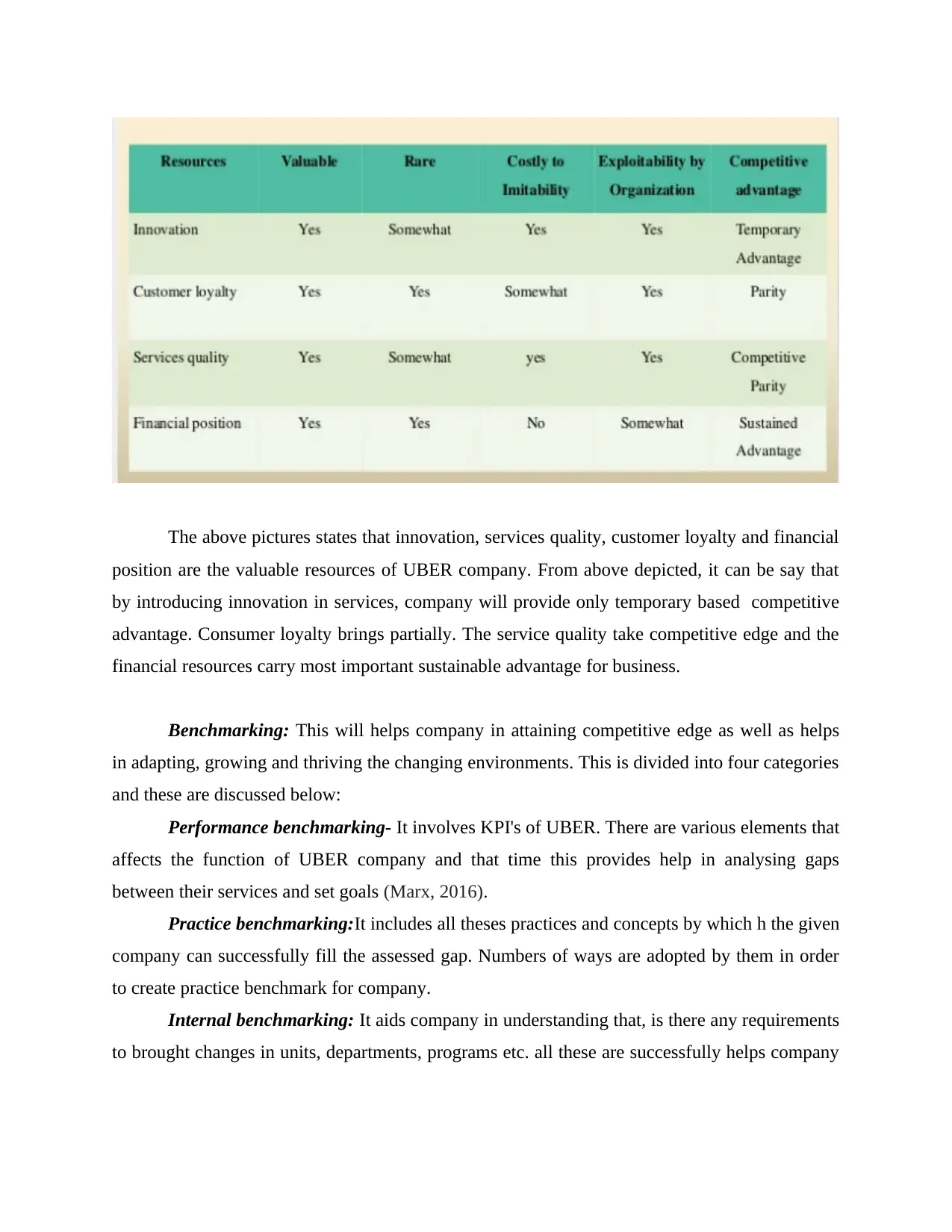
The above pictures states that innovation, services quality, customer loyalty and financial
position are the valuable resources of UBER company. From above depicted, it can be say that
by introducing innovation in services, company will provide only temporary based competitive
advantage. Consumer loyalty brings partially. The service quality take competitive edge and the
financial resources carry most important sustainable advantage for business.
Benchmarking: This will helps company in attaining competitive edge as well as helps
in adapting, growing and thriving the changing environments. This is divided into four categories
and these are discussed below:
Performance benchmarking- It involves KPI's of UBER. There are various elements that
affects the function of UBER company and that time this provides help in analysing gaps
between their services and set goals (Marx, 2016).
Practice benchmarking:It includes all theses practices and concepts by which h the given
company can successfully fill the assessed gap. Numbers of ways are adopted by them in order
to create practice benchmark for company.
Internal benchmarking: It aids company in understanding that, is there any requirements
to brought changes in units, departments, programs etc. all these are successfully helps company
position are the valuable resources of UBER company. From above depicted, it can be say that
by introducing innovation in services, company will provide only temporary based competitive
advantage. Consumer loyalty brings partially. The service quality take competitive edge and the
financial resources carry most important sustainable advantage for business.
Benchmarking: This will helps company in attaining competitive edge as well as helps
in adapting, growing and thriving the changing environments. This is divided into four categories
and these are discussed below:
Performance benchmarking- It involves KPI's of UBER. There are various elements that
affects the function of UBER company and that time this provides help in analysing gaps
between their services and set goals (Marx, 2016).
Practice benchmarking:It includes all theses practices and concepts by which h the given
company can successfully fill the assessed gap. Numbers of ways are adopted by them in order
to create practice benchmark for company.
Internal benchmarking: It aids company in understanding that, is there any requirements
to brought changes in units, departments, programs etc. all these are successfully helps company
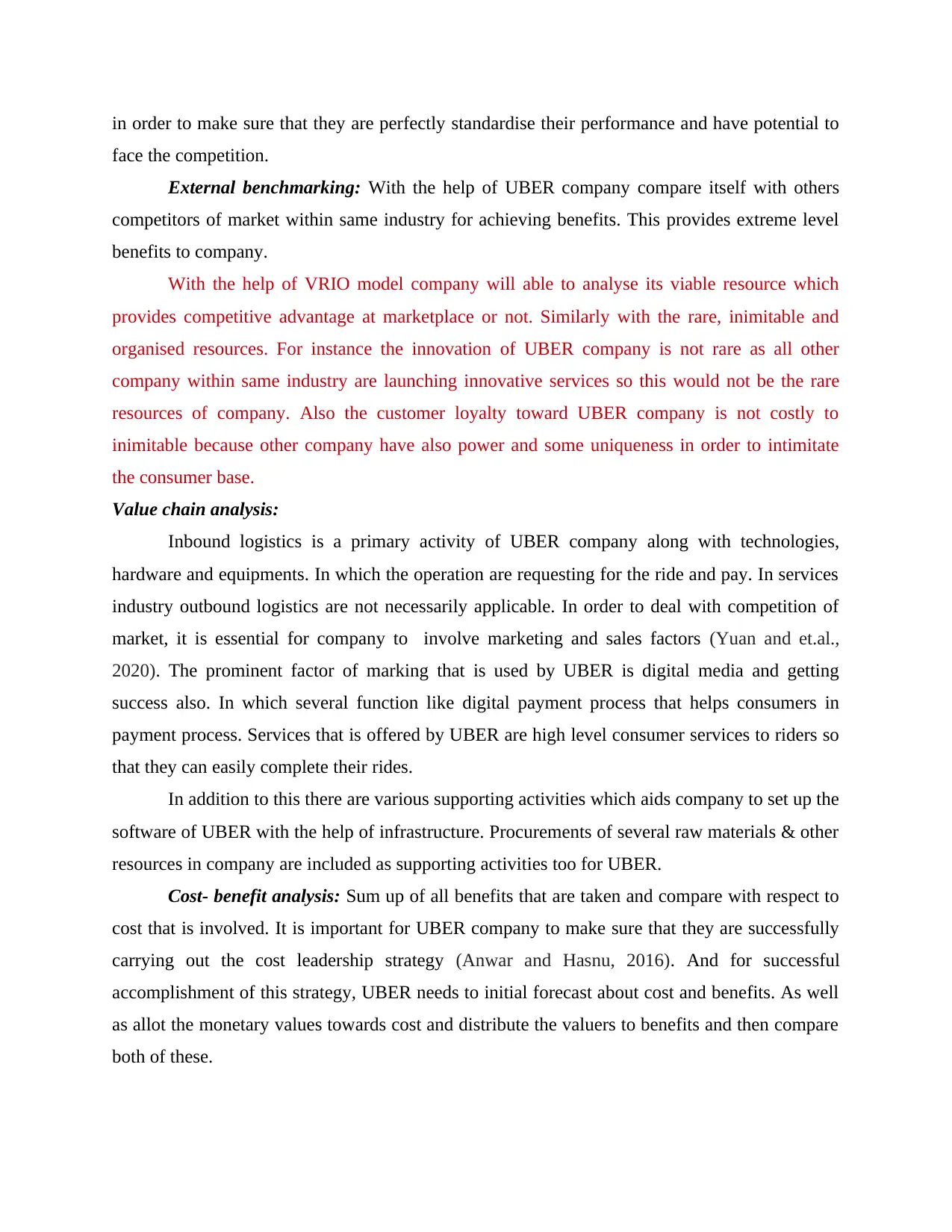
in order to make sure that they are perfectly standardise their performance and have potential to
face the competition.
External benchmarking: With the help of UBER company compare itself with others
competitors of market within same industry for achieving benefits. This provides extreme level
benefits to company.
With the help of VRIO model company will able to analyse its viable resource which
provides competitive advantage at marketplace or not. Similarly with the rare, inimitable and
organised resources. For instance the innovation of UBER company is not rare as all other
company within same industry are launching innovative services so this would not be the rare
resources of company. Also the customer loyalty toward UBER company is not costly to
inimitable because other company have also power and some uniqueness in order to intimitate
the consumer base.
Value chain analysis:
Inbound logistics is a primary activity of UBER company along with technologies,
hardware and equipments. In which the operation are requesting for the ride and pay. In services
industry outbound logistics are not necessarily applicable. In order to deal with competition of
market, it is essential for company to involve marketing and sales factors (Yuan and et.al.,
2020). The prominent factor of marking that is used by UBER is digital media and getting
success also. In which several function like digital payment process that helps consumers in
payment process. Services that is offered by UBER are high level consumer services to riders so
that they can easily complete their rides.
In addition to this there are various supporting activities which aids company to set up the
software of UBER with the help of infrastructure. Procurements of several raw materials & other
resources in company are included as supporting activities too for UBER.
Cost- benefit analysis: Sum up of all benefits that are taken and compare with respect to
cost that is involved. It is important for UBER company to make sure that they are successfully
carrying out the cost leadership strategy (Anwar and Hasnu, 2016). And for successful
accomplishment of this strategy, UBER needs to initial forecast about cost and benefits. As well
as allot the monetary values towards cost and distribute the valuers to benefits and then compare
both of these.
face the competition.
External benchmarking: With the help of UBER company compare itself with others
competitors of market within same industry for achieving benefits. This provides extreme level
benefits to company.
With the help of VRIO model company will able to analyse its viable resource which
provides competitive advantage at marketplace or not. Similarly with the rare, inimitable and
organised resources. For instance the innovation of UBER company is not rare as all other
company within same industry are launching innovative services so this would not be the rare
resources of company. Also the customer loyalty toward UBER company is not costly to
inimitable because other company have also power and some uniqueness in order to intimitate
the consumer base.
Value chain analysis:
Inbound logistics is a primary activity of UBER company along with technologies,
hardware and equipments. In which the operation are requesting for the ride and pay. In services
industry outbound logistics are not necessarily applicable. In order to deal with competition of
market, it is essential for company to involve marketing and sales factors (Yuan and et.al.,
2020). The prominent factor of marking that is used by UBER is digital media and getting
success also. In which several function like digital payment process that helps consumers in
payment process. Services that is offered by UBER are high level consumer services to riders so
that they can easily complete their rides.
In addition to this there are various supporting activities which aids company to set up the
software of UBER with the help of infrastructure. Procurements of several raw materials & other
resources in company are included as supporting activities too for UBER.
Cost- benefit analysis: Sum up of all benefits that are taken and compare with respect to
cost that is involved. It is important for UBER company to make sure that they are successfully
carrying out the cost leadership strategy (Anwar and Hasnu, 2016). And for successful
accomplishment of this strategy, UBER needs to initial forecast about cost and benefits. As well
as allot the monetary values towards cost and distribute the valuers to benefits and then compare
both of these.
⊘ This is a preview!⊘
Do you want full access?
Subscribe today to unlock all pages.

Trusted by 1+ million students worldwide
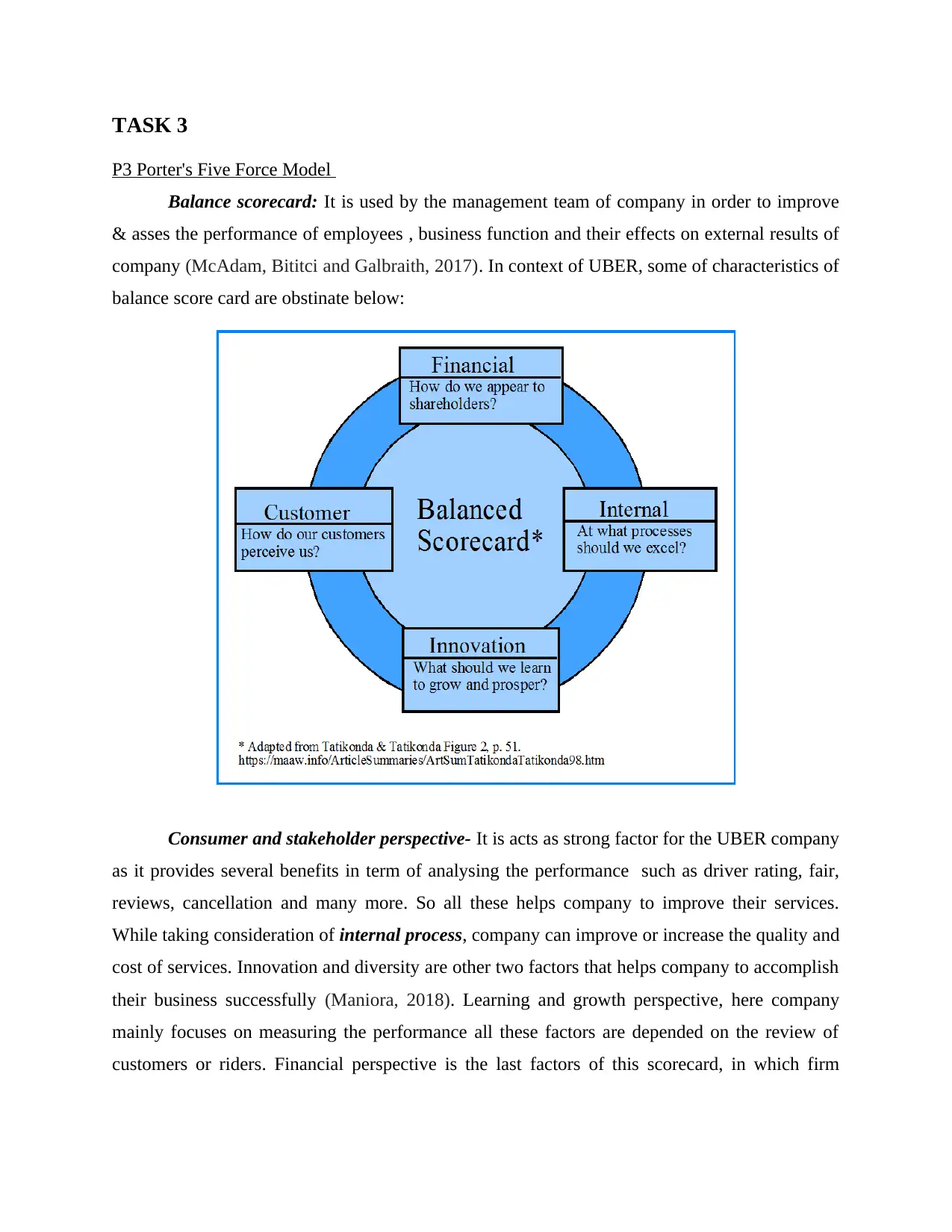
TASK 3
P3 Porter's Five Force Model
Balance scorecard: It is used by the management team of company in order to improve
& asses the performance of employees , business function and their effects on external results of
company (McAdam, Bititci and Galbraith, 2017). In context of UBER, some of characteristics of
balance score card are obstinate below:
Consumer and stakeholder perspective- It is acts as strong factor for the UBER company
as it provides several benefits in term of analysing the performance such as driver rating, fair,
reviews, cancellation and many more. So all these helps company to improve their services.
While taking consideration of internal process, company can improve or increase the quality and
cost of services. Innovation and diversity are other two factors that helps company to accomplish
their business successfully (Maniora, 2018). Learning and growth perspective, here company
mainly focuses on measuring the performance all these factors are depended on the review of
customers or riders. Financial perspective is the last factors of this scorecard, in which firm
P3 Porter's Five Force Model
Balance scorecard: It is used by the management team of company in order to improve
& asses the performance of employees , business function and their effects on external results of
company (McAdam, Bititci and Galbraith, 2017). In context of UBER, some of characteristics of
balance score card are obstinate below:
Consumer and stakeholder perspective- It is acts as strong factor for the UBER company
as it provides several benefits in term of analysing the performance such as driver rating, fair,
reviews, cancellation and many more. So all these helps company to improve their services.
While taking consideration of internal process, company can improve or increase the quality and
cost of services. Innovation and diversity are other two factors that helps company to accomplish
their business successfully (Maniora, 2018). Learning and growth perspective, here company
mainly focuses on measuring the performance all these factors are depended on the review of
customers or riders. Financial perspective is the last factors of this scorecard, in which firm
Paraphrase This Document
Need a fresh take? Get an instant paraphrase of this document with our AI Paraphraser
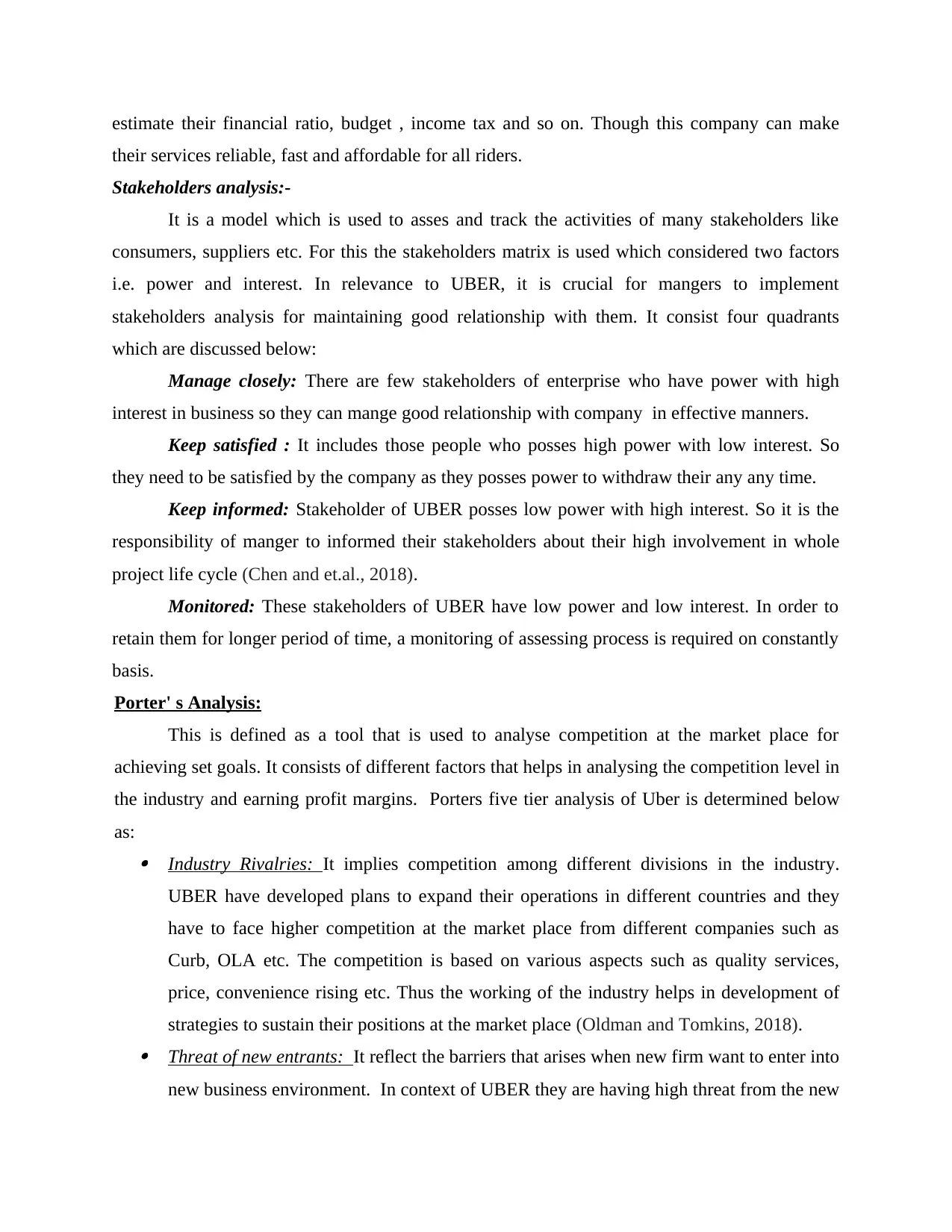
estimate their financial ratio, budget , income tax and so on. Though this company can make
their services reliable, fast and affordable for all riders.
Stakeholders analysis:-
It is a model which is used to asses and track the activities of many stakeholders like
consumers, suppliers etc. For this the stakeholders matrix is used which considered two factors
i.e. power and interest. In relevance to UBER, it is crucial for mangers to implement
stakeholders analysis for maintaining good relationship with them. It consist four quadrants
which are discussed below:
Manage closely: There are few stakeholders of enterprise who have power with high
interest in business so they can mange good relationship with company in effective manners.
Keep satisfied : It includes those people who posses high power with low interest. So
they need to be satisfied by the company as they posses power to withdraw their any any time.
Keep informed: Stakeholder of UBER posses low power with high interest. So it is the
responsibility of manger to informed their stakeholders about their high involvement in whole
project life cycle (Chen and et.al., 2018).
Monitored: These stakeholders of UBER have low power and low interest. In order to
retain them for longer period of time, a monitoring of assessing process is required on constantly
basis.
Porter' s Analysis:
This is defined as a tool that is used to analyse competition at the market place for
achieving set goals. It consists of different factors that helps in analysing the competition level in
the industry and earning profit margins. Porters five tier analysis of Uber is determined below
as: Industry Rivalries: It implies competition among different divisions in the industry.
UBER have developed plans to expand their operations in different countries and they
have to face higher competition at the market place from different companies such as
Curb, OLA etc. The competition is based on various aspects such as quality services,
price, convenience rising etc. Thus the working of the industry helps in development of
strategies to sustain their positions at the market place (Oldman and Tomkins, 2018). Threat of new entrants: It reflect the barriers that arises when new firm want to enter into
new business environment. In context of UBER they are having high threat from the new
their services reliable, fast and affordable for all riders.
Stakeholders analysis:-
It is a model which is used to asses and track the activities of many stakeholders like
consumers, suppliers etc. For this the stakeholders matrix is used which considered two factors
i.e. power and interest. In relevance to UBER, it is crucial for mangers to implement
stakeholders analysis for maintaining good relationship with them. It consist four quadrants
which are discussed below:
Manage closely: There are few stakeholders of enterprise who have power with high
interest in business so they can mange good relationship with company in effective manners.
Keep satisfied : It includes those people who posses high power with low interest. So
they need to be satisfied by the company as they posses power to withdraw their any any time.
Keep informed: Stakeholder of UBER posses low power with high interest. So it is the
responsibility of manger to informed their stakeholders about their high involvement in whole
project life cycle (Chen and et.al., 2018).
Monitored: These stakeholders of UBER have low power and low interest. In order to
retain them for longer period of time, a monitoring of assessing process is required on constantly
basis.
Porter' s Analysis:
This is defined as a tool that is used to analyse competition at the market place for
achieving set goals. It consists of different factors that helps in analysing the competition level in
the industry and earning profit margins. Porters five tier analysis of Uber is determined below
as: Industry Rivalries: It implies competition among different divisions in the industry.
UBER have developed plans to expand their operations in different countries and they
have to face higher competition at the market place from different companies such as
Curb, OLA etc. The competition is based on various aspects such as quality services,
price, convenience rising etc. Thus the working of the industry helps in development of
strategies to sustain their positions at the market place (Oldman and Tomkins, 2018). Threat of new entrants: It reflect the barriers that arises when new firm want to enter into
new business environment. In context of UBER they are having high threat from the new
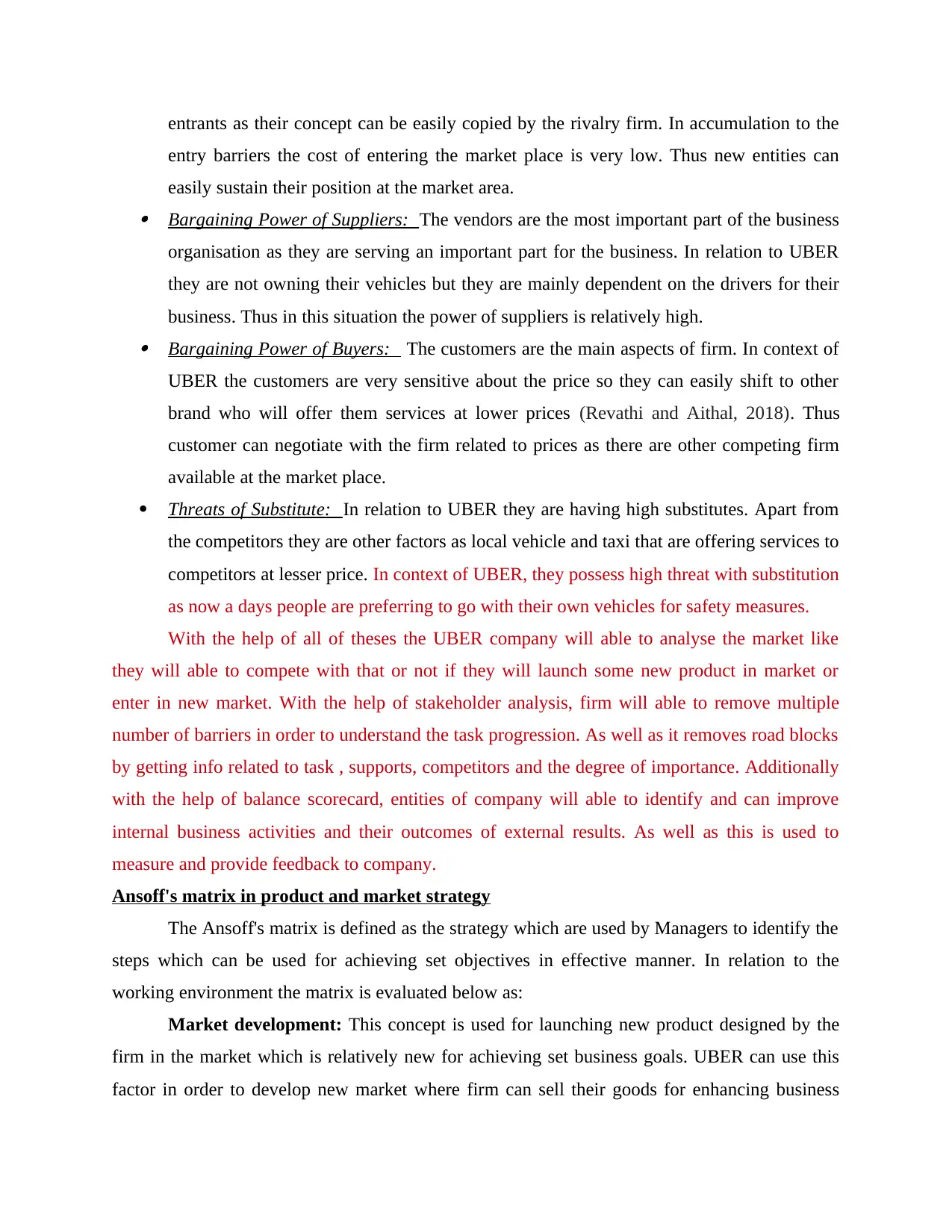
entrants as their concept can be easily copied by the rivalry firm. In accumulation to the
entry barriers the cost of entering the market place is very low. Thus new entities can
easily sustain their position at the market area. Bargaining Power of Suppliers: The vendors are the most important part of the business
organisation as they are serving an important part for the business. In relation to UBER
they are not owning their vehicles but they are mainly dependent on the drivers for their
business. Thus in this situation the power of suppliers is relatively high. Bargaining Power of Buyers: The customers are the main aspects of firm. In context of
UBER the customers are very sensitive about the price so they can easily shift to other
brand who will offer them services at lower prices (Revathi and Aithal, 2018). Thus
customer can negotiate with the firm related to prices as there are other competing firm
available at the market place.
Threats of Substitute: In relation to UBER they are having high substitutes. Apart from
the competitors they are other factors as local vehicle and taxi that are offering services to
competitors at lesser price. In context of UBER, they possess high threat with substitution
as now a days people are preferring to go with their own vehicles for safety measures.
With the help of all of theses the UBER company will able to analyse the market like
they will able to compete with that or not if they will launch some new product in market or
enter in new market. With the help of stakeholder analysis, firm will able to remove multiple
number of barriers in order to understand the task progression. As well as it removes road blocks
by getting info related to task , supports, competitors and the degree of importance. Additionally
with the help of balance scorecard, entities of company will able to identify and can improve
internal business activities and their outcomes of external results. As well as this is used to
measure and provide feedback to company.
Ansoff's matrix in product and market strategy
The Ansoff's matrix is defined as the strategy which are used by Managers to identify the
steps which can be used for achieving set objectives in effective manner. In relation to the
working environment the matrix is evaluated below as:
Market development: This concept is used for launching new product designed by the
firm in the market which is relatively new for achieving set business goals. UBER can use this
factor in order to develop new market where firm can sell their goods for enhancing business
entry barriers the cost of entering the market place is very low. Thus new entities can
easily sustain their position at the market area. Bargaining Power of Suppliers: The vendors are the most important part of the business
organisation as they are serving an important part for the business. In relation to UBER
they are not owning their vehicles but they are mainly dependent on the drivers for their
business. Thus in this situation the power of suppliers is relatively high. Bargaining Power of Buyers: The customers are the main aspects of firm. In context of
UBER the customers are very sensitive about the price so they can easily shift to other
brand who will offer them services at lower prices (Revathi and Aithal, 2018). Thus
customer can negotiate with the firm related to prices as there are other competing firm
available at the market place.
Threats of Substitute: In relation to UBER they are having high substitutes. Apart from
the competitors they are other factors as local vehicle and taxi that are offering services to
competitors at lesser price. In context of UBER, they possess high threat with substitution
as now a days people are preferring to go with their own vehicles for safety measures.
With the help of all of theses the UBER company will able to analyse the market like
they will able to compete with that or not if they will launch some new product in market or
enter in new market. With the help of stakeholder analysis, firm will able to remove multiple
number of barriers in order to understand the task progression. As well as it removes road blocks
by getting info related to task , supports, competitors and the degree of importance. Additionally
with the help of balance scorecard, entities of company will able to identify and can improve
internal business activities and their outcomes of external results. As well as this is used to
measure and provide feedback to company.
Ansoff's matrix in product and market strategy
The Ansoff's matrix is defined as the strategy which are used by Managers to identify the
steps which can be used for achieving set objectives in effective manner. In relation to the
working environment the matrix is evaluated below as:
Market development: This concept is used for launching new product designed by the
firm in the market which is relatively new for achieving set business goals. UBER can use this
factor in order to develop new market where firm can sell their goods for enhancing business
⊘ This is a preview!⊘
Do you want full access?
Subscribe today to unlock all pages.

Trusted by 1+ million students worldwide
1 out of 16
Related Documents
Your All-in-One AI-Powered Toolkit for Academic Success.
+13062052269
info@desklib.com
Available 24*7 on WhatsApp / Email
![[object Object]](/_next/static/media/star-bottom.7253800d.svg)
Unlock your academic potential
Copyright © 2020–2025 A2Z Services. All Rights Reserved. Developed and managed by ZUCOL.





